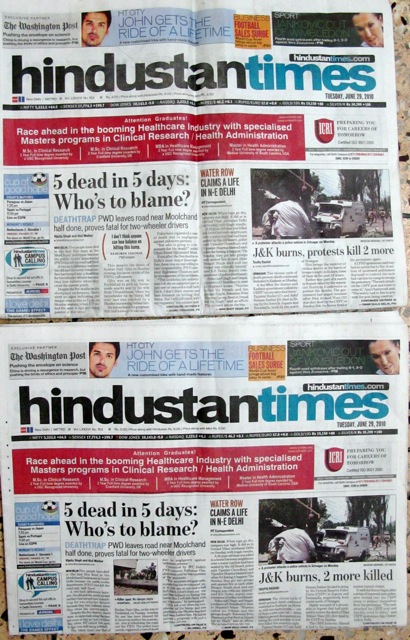Life is a little complicated right now, and this means that blogging has been slow. This shall continue to be the case for the next few days. However, I will try and find sometime in between crisis to come back here and talk about a lot of things that I have been wanting to put out there.
First amongst these is my friend Shivam Vij’s take-down of the Indian media’s coverage of the killings in Kashmir of demonstrators when police and paramilitary forces opened fire on them. The dead were mostly Kahmiri youth between 9 and 22 years. Shivam points out how despite these extrajudicial executions, Kashmiri protesters garnered a largely unsympathetic reaction from the Indian press:
***
And how does the press respond? The killing of a nine year old boy by the CRPF was frontpage in all the Delhi papers. Have a look at two copies of the same day’s Hindustan Times, Delhi edition, and spot the difference:
The early city edition’s headline read, “J&K burns, protests kill two more.” I couldn’t take my eyes off that headline for a while. It was, I thought, like saying ‘Protests Kill Hundreds in Jallianwala Bagh.’ Protest does not kill. Bullets do.
They must have realised how darn wicked that is, and changed it on the late city edition to, “J&K burns, 2 more killed”. While making the change, they didn’t say CRPF killed them. They just got killed.
That is not all. The day’s lead story was also about death – it’s all about death in India these days – death by accident. Death by accident on the Moolchand underpass, not far from where I live. The headline had a question: “5 dead in 5 days. Who’s to blame?” The stroy strongly attacked the Public Works Department of the Delhi state government for faulty road construction and for not putting a warning sign. In the late city edition they even got photographic evidence. In the Kashmir story, however, there were no questions, no blaming, no tone of outrage. Reporting the Sopre firing from Srinagar, the copy went:
The vicious cycle of death-protest-death continued unabated in Kashmir on Monday.
A day after the Jammu and Kashmir government called the CRPF “an uncontrolled force”, Tajamul Bashir (17) and Ashif Hasan Rather (9) died in firing by the force in Sopore and Baramulla, both 55 km north of Srinagar.
This brings the number of civilian deaths at the hands of troops to eight in 15 days, three of them in the past 24 hours.
Rather was part of a march to Sopore called by the separatist Hurriyat Conference to protest the deaths.
[continues]
Now see the changed late city version:
The vicious cycle of death-protest-death continued unabated in Kashmir on Monday, with two more youths — one of them a nine year old — being killed in protest demonstrations, taking the total number of civilians killed this month to eight.
Tajamul Bashir (17) and Ashif Hassan Rather (9) died in firing by the Central Reserve Police Force (CRPF) in Sopore and Baramulla, respectively, both towns north of Srinagar.
Bashir was part of a procession in Sopore that had gathered to mourn the death of Bilal Ahmed Wani (22), shot dead by the CRPF on Sunday.
The CRPF, however, claimed it had to fire because the procession turned violent.
It said the fracas began after a group of unarmed state policemen rushed into the CRPF camp to protect themselves from the protesters. “The mob attacked the CRPF post and forcibly tried to enter,“ said CRPF spokesman Ajay Chaturvedi in Delhi.
“The sentry had no option but to fire,“ he said.Similarly, nine-year-old Rather had joined a march called by the separatist All Party Hurriyat Conference, from Srinagar to Sopore, to protest Wani’s killing. Though all top Hurriyat leaders were arrested following the call, a large crowd assembled and the march began.
Their numbers swelled fur- ther at Baramulla, breaking down barricades placed by the police and attacking police vehicles, following which they were fired upon.
The current round of escalating violence began after a Sopore youth Tufail Ahmed Matoo (17), during a routine protest on June 11, was hit by a tear gas shell on the head and succumbed to his injuries. Violent protests and fierce repression have been a regular feature since then.
With inputs from New Delhi
The early city report gave the impression that 9-year-old Rather’s participation in the protest march called by separatists – yes, separatists! – justified his killing. That is toned down in the second version. The tone of outrage used in the Delhi accident story is completely missing. The CRPF spokesperson is quoted by the dead boys’ parents, or eyewitnesses, are not to be bothered with.
What is most interesting is the phrase “vicious cycle” – it’s a phrase that explains away the spate of “violence”. Protest, stone-pelting, fake encounters, militant clashes, strikes and the quelling of protests by killing unarmed or stone-pelting protestors – this is reported in the Delhi media not just with a lot of obfuscation and dishonesty, but also with a deliberate sense of confusion. A lay reader gets a general, vague image of “violence” – it’s just a lot of random violence taking place in Kashmir. Then, in op-eds and special reports, TV debates and Arnab Goswami’s yelling all get together to assure the Indian middle class that it’s all about Pakistan-Geelani-militancy-Islamism. And so, kill we must.
***
Read the complete story on Kafila, where Shivam also writes about his impressions of Kashmir on traveling there for a month.






This is such a helpful resource you are offering and you’re giving it away free of charge. I enjoy discovering weblogs that understand the value of providing a valuable resource for free of charge. I genuinely enjoyed reading your article 🙂 Thanks!